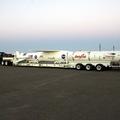
WIKIARCHIVES.SPACE
The Human Spaceflight Archive

Information
- Taken in
- Vandenberg
- Author
- NASA
- Description
- The SciSat-1 payload, with fairing installed and attached to its Pegasus launch vehicle, arrives at the pad for mating to the L-1011 carrier aircraft. The SciSat-1 weighs approximately 330 pounds and after launch will be placed in a 400-mile-high polar orbit to investigate processes that control the distribution of ozone in the upper atmosphere. The data from the satellite will provide Canadian and international scientists with improved measurements relating to global ozone processes and help policymakers assess existing environmental policy and develop protective measures for improving the health of our atmosphere, preventing further ozone depletion. The mission is designed to last two years.
- Created on
- Saturday 9 August 2003
- Albums
- US SPACE PROGRAM / SATELLITES / PEGASUS XL / SCISAT-1 / Rocket preparation
- Source link
- https://science.ksc.nasa.gov/gallery/photos/2003/
- Visits
- 25
- Rating score
- no rate
- Rate this photo
- License
- CC BY-NC-ND
- Modified by WikiArchives
- No (original)
- Downloads
- 0
Powered by Piwigo











